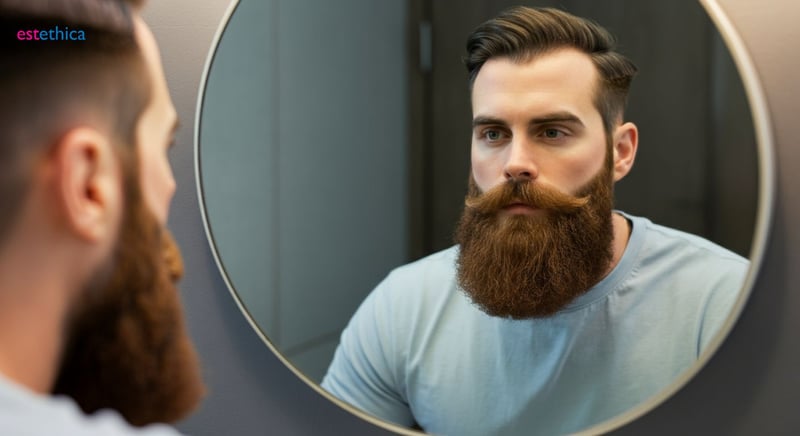Unlocking the Full Beard Potential: A Beard Transplant Guide
Experience a fuller, natural beard transformation with advanced techniques like FUE and DHI, perfect for overcoming patchy growth.
The journey to a fuller beard often leads many to consider advanced solutions like beard transplants. As a minimally invasive procedure that uses techniques perfected in hair restoration, beard transplants can transform patchy growth into robust facial hair. This guide explores the ins and outs of beard transplantation, helping you discover whether it's the right choice for you. By understanding the cost, procedure, and recovery, you can determine if this transformational process aligns with your grooming goals.
Beard Hair Transplant: Is It Right for You?
Understanding the Benefits of a Beard Transplant
Considering a beard transplant involves understanding your personal goals and expectations from the procedure. Typically employed to overcome patchy beard growth, this solution can remarkably enhance self-confidence and facial aesthetics. Consulting with a skilled specialist ensures that the procedure aligns with your desired outcome. A professional can also discuss different techniques such as FUE or DHI, ensuring you receive personalized guidance to achieve your beard ambitions.
Factors to Consider Before Opting for a Facial Hair Transplant
- Evaluate your donor hair availability: Adequate and healthy donor hair is crucial for a successful beard hair transplant.
- Consider the recovery duration: Planning for the post-operative care is necessary to ensure proper healing and the best results from your facial hair transplant.
- Discuss potential outcomes with your surgeon: Setting feasible expectations is key to being satisfied with the results post-procedure.

From Patchy to Perfect: Understanding the Beard Transplant Process
Refining Facial Aesthetics with Modern Transplant Techniques
The transformation journey from patchy to perfect involves skilled extraction and transplantation processes. Techniques like Follicular Unit Extraction (FUE) and Direct Hair Implantation (DHI) are favored for their precision in placing hair follicles. estethica's superior methods guarantee natural-looking results that meet individual aesthetic goals. The process requires careful planning to replicate the natural direction and density of facial hair, ensuring an organic appearance. A successful beard transplant not only fills in gaps but also enhances the overall facial harmony.
Essential Steps in the Beard Transplant Procedure
- Initial Consultation and Planning: A detailed assessment helps tailor the procedure to meet aesthetic expectations.
- Hair Follicle Extraction: Precise techniques ensure minimal scarring and optimal graft survival.
- Graft Placement: Skilled placement mimics natural hair direction, critical for a natural-looking beard.

Facial Hair Transplant Techniques: FUE, DHI, and More
Exploring FUE and DHI for Beard Transplants
Among the primary techniques used in facial hair transplant are FUE and DHI. The FUE technique allows individual follicles to be moved from donor areas to the beard zone, while DHI involves direct implantation, providing shorter recovery times and minimized invasiveness. Each method has its benefits, and selecting the ideal approach depends on your specific hair growth pattern and personal preferences. Patients find that understanding these methods helps them approach the beard hair transplant process with confidence. At estethica, we are committed to providing advanced solutions with both FUE and DHI to meet the unique needs of each patient seeking a fuller beard through facial hair restoration.
Factors Influencing the Choice of Transplant Method
- Density Desired: The extent of coverage needed affects the chosen beard transplant technique.
- Recovery Expectations: DHI may be favored for quicker healing, fitting into a busy lifestyle.
- Hair Type and Texture: Matching donor hair characteristics with beard texture is crucial for natural results.

Beard Transplant Before & After: What to Expect From Recovery
Navigating the Post-Procedure Phase of a Beard Transplant
Post-procedure, patients typically experience mild swelling or redness which subsides quickly. With procedures performed at estethica, innovative healing protocols using patented creams and supportive therapies like PRP can greatly enhance recovery rates. Expect visible results to start showing as early as three to six months. It's crucial to follow post-operative care instructions closely to ensure optimal healing and hair growth. The success of a beard transplant depends significantly on meticulous aftercare, ensuring a fuller, healthier beard emerges over time. estethica emphasizes personalized follow-up care to optimize each patient's outcome.
Key Steps for Optimizing Recovery After Your Facial Hair Transplant
- Gentle Skincare: Use only recommended products to avoid irritating the transplanted area.
- Avoid Strenuous Activities: Refrain from heavy exercise in the first few weeks to aid healing.
- Follow-Up Visits: Attend all scheduled appointments at estethica for progress monitoring and adjustments.
Precision Beard Restoration with FUE and DHI Techniques
estethica employs advanced techniques such as Follicular Unit Extraction (FUE) and Direct Hair Implantation (DHI) for beard transplants, ensuring precise placement and natural-looking results. These methods minimize invasiveness and promote faster recovery, aligning with individual hair growth patterns and aesthetic preferences.
estethica’s skilled specialists offer personalized guidance, tailoring beard transplant procedures to meet each patient’s unique goals and expectations. They carefully assess donor hair availability and discuss potential outcomes to ensure complete patient satisfaction and achieve desired beard ambitions.
Optimized Recovery and Natural Growth Through Personalized Aftercare
estethica emphasizes meticulous aftercare, using patented creams and supportive therapies like PRP to enhance recovery rates post-beard transplant. Personalized follow-up care ensures optimal healing and hair growth, leading to a fuller, healthier beard.
Patients at estethica experience reduced swelling and redness post-procedure, with visible results appearing as early as three to six months. Following post-operative care instructions closely ensures the success of the beard transplant and the emergence of a natural-looking, fuller beard.
Frequently Asked Questions
What are the primary benefits of undergoing a beard transplant?
What is the typical recovery process after a facial hair transplant procedure?
How do FUE and DHI techniques differ in a beard hair transplant, and which is better?
What key factors should I consider to optimize recovery after my beard transplant?
Ready for a healthier and more aesthetic you with estethica's expert team?
📞 Book Your Free Consultation!